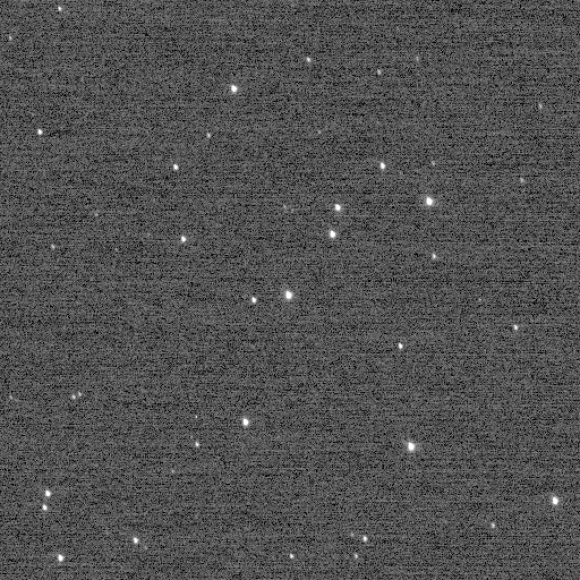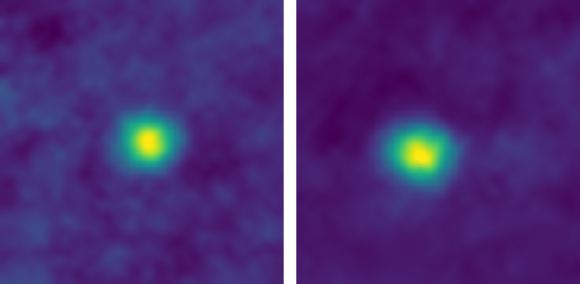In July of 2015, the New Horizons mission made history by being the first spacecraft to rendezvous with Pluto. In the course of conducting its flyby, the probe gathered volumes of data about Pluto’s surface, composition, atmosphere and system of moons. It also provided breathtaking images of Pluto’s “heart”, its frozen plains, mountain chains, and it’s mysterious “bladed terrain”.
Since that time, New Horizons has carried on to the Kuiper Belt for the sake of conducting more historic encounters. In preparation for these, the probe also established new records when it used its Long Range Reconnaissance Imager (LORRI) to take a series of long-distance pictures. These images, which have since been released to the public, have set the new record for the most distant images ever taken.
At present, the New Horizons probe is at a distance of 6.12 billion km (3.79 billion mi) from Earth. This means that images taken at this point are at a distance of 40.9 Astronomical Units (AUs), or the equivalent of about 41 times the distance between Earth and the Sun. This it slightly farther than the “Pale Blue Dot” image of Earth, which was snapped by the Voyager 1 mission when it was at a distance of 6.06 billion km (3.75 billion mi; 40.5 AU) from Earth.
Image of the “Wishing Well” star cluster, taken Dec. 5, 2017, which temporarily broke the 27-year record set by Voyager 1. Credit: NASA/JHUAPL/SwRI
However, in December of 2017, the New Horizons team began conducting a routine calibration test of the LORRI instrument. This consisted of snapping pictures of the “Wishing Well” cluster (aka. the “Football Cluster” or NGC 3532), an open galactic star cluster that is located about 1321 light years from Earth in the direction of the southern constellation of Carina.
This image (shown above) was rather significant, given that this star cluster was the first target ever observed by the Hubble Space Telescope (on May 20th, 1990). While this image broke the long-distance record established by Voyager 1, the probe then turned its LORRI instrument towards objects in its flight path. As part of the probes mission to rendezvous with a KBO, the team was searching for forward-scattering rings or dust.
As a result, just two hours after it had taken the record-breaking image of the “Wishing Well” star cluster, the probe snapped pictures of the Kuiper Belt Objects (KBOs) known as 2012 HZ84 and 2012 HE85 (seen below, left and right). These images once again broke the record for being the most distant images taken from Earth (again), but also set a new record for the closest-ever images ever taken of KBOs.
False-color images of KBOs 2012 HZ84 (left) and 2012 HE85, taken by LORRI, are the farthest from Earth ever captured by a spacecraft. Credit: NASA/JHUAPL/SwRI
“New Horizons has long been a mission of firsts — first to explore Pluto, first to explore the Kuiper Belt, fastest spacecraft ever launched. And now, we’ve been able to make images farther from Earth than any spacecraft in history.”As one of only five spacecraft to travel beyond the Outer Planets, New Horizons has set a number of other distance records as well. These include the most-distant course-correction maneuver, which took place on Dec. 9th, 2017, and guided the spacecraft towards its planned flyby with the KBO 2014 MU69. This event, which will happen on Jan. 1st, 2019, will be the farthest planetary encounter in history.
In the course of its extended mission in the Kuiper Belt, the New Horizons team seeks to observe at least two-dozen other KBOs, dwarf planets and “Centaurs” – i.e. former KBOs that have unstable orbits that cause them to cross the orbit of the gas giants. At present, the New Horizons spacecraft is in hibernation and will be brought back online on June 4th, – when it will begin a series of checks to make sure it is ready for its planned encounter with MU69.
The spacecraft is also conducting nearly continuous measurements of the Kuiper Belt itself to learn more about its plasma, dust and neutral-gas environment. These efforts could reveal much about the formation and evolution of the Solar System, and are setting records that are not likely to be broken for many more decades!
Further Reading: NASA
The post New Horizons Just Took a Record Breaking Image. No Camera Has Ever Taken a Picture From This Far From Earth appeared first on Universe Today.


No comments:
Post a Comment